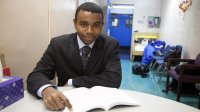Ten Takeaway Tips for Using Authentic Assessment in Your School
How you can get started.
The School of the Future's (SOF) mission is to empower each and every student. Teachers accomplish this not only by making their classroom content and instruction engaging but also by making their assessments authentic.
Teachers ask SOF students to demonstrate their comprehension and mastery of the curriculum in ways that are meaningful to them. This goes beyond getting the "right" answers on tests. At SOF, students develop the learning skills and habits of mind that are essential in the classroom -- and the rest of their lives. Here are ten tips to help you use authentic assessment in your school.
1. Break Down Skill Work into Small Steps
Authentic assessment can seem overwhelming at first. Take little steps such as collecting data one day a week, analyzing it, and using the results to group students for the next week. Use a goal-setting sheet with other teachers and lay out short- and long-term plans to achieve those goals. Develop a system to track learning that works for you. Set time limits for collecting and analyzing data so you don't set the bar too high for yourself.
2. Build a Community of Practice
Authentic assessment can be deeply rewarding for everyone involved, but it does take time and effort and can be demanding on teachers. It should not become overwhelming, however. Teachers can work together to create dedicated common planning time for sharing their strategies, challenges, and eureka moments. School leaders should join the meetings as often as possible to help strengthen teacher community. (Talk to others who care about assessment in Edutopia's Assessment Group.)
3. Work Backwards
SOF teachers design their concluding summative assessments first. These assessments are based on what the teachers would like the students to ultimately show as a demonstration of their learning. The teachers then create lessons and smaller-scale formative assessments that will help students build toward those final assessments. Teachers approach units as ongoing works-in-progress, which culminate in a project or presentation. While students are deep in the grip of researching, writing, editing, building, and creating, teachers are observing and questioning student progress all along the way, constantly and organically doing assessments to discover students' grasp of the material.
4. Have Fun
Authentic assessments engage students when they are fun and interesting, so try to think of entertaining ways to approach your content. In one humanities class at SOF, students dress like ancient Egyptians and put on a play to demonstrate they are learning the content. In physics, they build a catapult to learn about velocity and acceleration.
5. Ensure Rigor
You can be creative with authentic assessments, but you still have to base your assessments on the standards you are teaching. Develop rubrics that will show you exactly what your students are learning. Share these rubrics with your students so they’ll have a clear idea of what you want them to accomplish and how you expect them to demonstrate it.
6. Give Cards a Try
Simple index cards or Post-it notes are a great way to get a snapshot of where your students are in their learning. Ask students to answer one or two questions on a card or Post-it on the way into class as a warm-up activity, on the way out of class, or as a homework assignment. You can then quickly review the cards to get a lot of helpful information to guide your instruction.
7. Tap into Students' Interests
Children are passionate about so many things. Tapping into students' interests is one way to get useful assessment data and to help students take ownership of and deepen their own learning. At SOF, kids who love video games study projectile motion in the online game World of Warcraft. Students who enjoy art and creative writing create graphic novels about the book Persepolis. The students' own interests get the ball rolling and open them up to a variety of ongoing and authentic assessment techniques.
8. Use Tasks on Demand
There is no one simple diagnostic tool that tells the whole story, so try a number of strategies to get a more well-rounded picture of your students. Tasks on demand, or TODs, are a powerful way to get a snapshot of student comprehension. TODs are quick in-class assessments given without warning and without any scaffolding or help. The goal of a TOD is to determine if students can actually apply the knowledge they've been learning. One way to make TODs more rigorous is to give students problems with incorrect answers and then ask them to explain why they are wrong.
9. DYO: Do Your Own Assessments
Set aside time for the kids to reflect and write about their own progress. Let them explain their process and approach to a certain skill as well as their opinion on the current unit, text, or concept. How they are thinking about the concept is as important and revealing as their ability to give a "right" answer. Students' ownership of their own learning is at the core of authentic assessment.
10. Use a Variety of Tracking Tools
There are a variety of low- and high-tech tools that can help teachers track their students' progress. Technology lovers use applications like Easy Grade Pro to track particular skills. Others prefer a more traditional approach and use pen and paper, tables, or spreadsheets to chart student progress at any given time. The most important thing is to find what works for you and to look at tracking as part of the whole assessment process.
What do you think of Schools that Work?
Tweet your answer to @edutopia or post your comment below.
School Of The Future
Enrollment
689 | Public, UrbanPer Pupil Expenditures
$5000 per general ed student per the Fair Student Funding formula.Free / Reduced Lunch
40%DEMOGRAPHICS:
2% English-language learners
17% Individualized education programs
